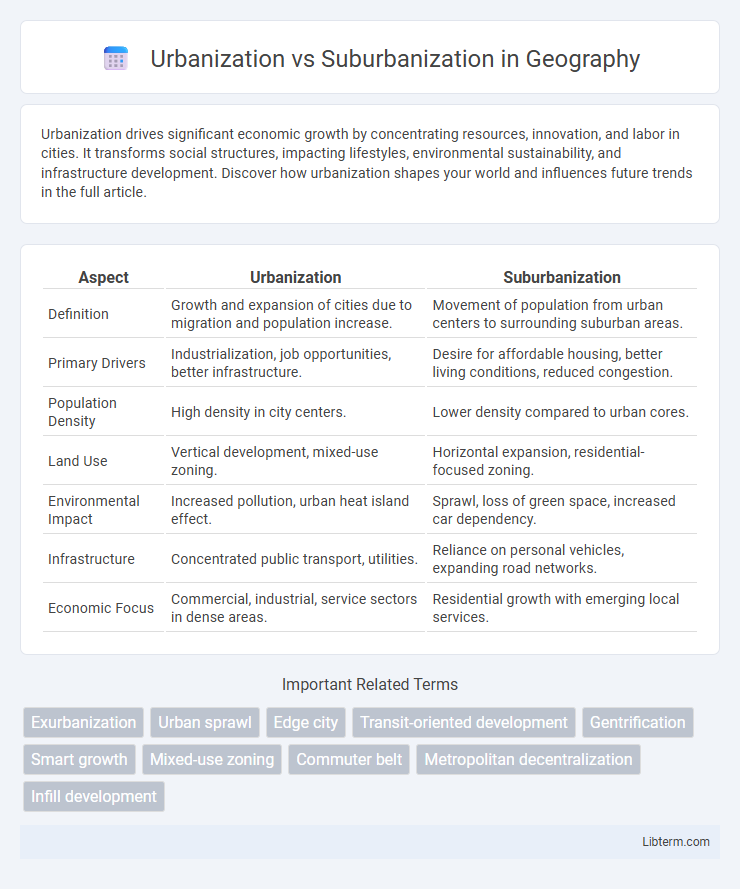Urbanization drives significant economic growth by concentrating resources, innovation, and labor in cities. It transforms social structures, impacting lifestyles, environmental sustainability, and infrastructure development. Discover how urbanization shapes your world and influences future trends in the full article.
Table of Comparison
| Aspect | Urbanization | Suburbanization |
|---|---|---|
| Definition | Growth and expansion of cities due to migration and population increase. | Movement of population from urban centers to surrounding suburban areas. |
| Primary Drivers | Industrialization, job opportunities, better infrastructure. | Desire for affordable housing, better living conditions, reduced congestion. |
| Population Density | High density in city centers. | Lower density compared to urban cores. |
| Land Use | Vertical development, mixed-use zoning. | Horizontal expansion, residential-focused zoning. |
| Environmental Impact | Increased pollution, urban heat island effect. | Sprawl, loss of green space, increased car dependency. |
| Infrastructure | Concentrated public transport, utilities. | Reliance on personal vehicles, expanding road networks. |
| Economic Focus | Commercial, industrial, service sectors in dense areas. | Residential growth with emerging local services. |
Understanding Urbanization and Suburbanization
Urbanization refers to the increasing population concentration in city areas due to migration and economic opportunities, leading to expanded infrastructure and higher-density living. Suburbanization involves the growth of residential zones on the outskirts of cities, characterized by lower population density, more green spaces, and commuting patterns to urban centers. Understanding these processes reveals their impact on land use, transportation systems, and regional development dynamics.
Historical Context and Evolution
Urbanization surged during the Industrial Revolution as people migrated to cities seeking factory jobs, sparking rapid city growth and infrastructure development. Suburbanization gained momentum post-World War II, driven by increased automobile ownership, affordable housing, and government policies promoting suburban living. This shift resulted in widespread residential expansion beyond urban centers, reshaping metropolitan areas worldwide.
Key Characteristics: Urban vs Suburban Living
Urban living features high population density, extensive public transportation, and diverse cultural amenities, fostering a fast-paced lifestyle with numerous job opportunities. Suburban living offers lower population density, primarily residential neighborhoods, and reliance on private vehicles, emphasizing larger homes and green spaces. The contrast highlights urban areas as economic and social hubs, while suburbs prioritize family-friendly environments and quieter surroundings.
Population Density and Housing Trends
Urbanization drives higher population density as more people concentrate in city centers, leading to the development of high-rise apartments and mixed-use housing. Suburbanization results in lower population density with sprawling residential zones characterized by single-family homes and larger lot sizes. Housing trends reveal urban areas favor vertical growth and compact living, while suburbs emphasize horizontal expansion and suburban-style neighborhoods.
Economic Opportunities and Employment Patterns
Urbanization concentrates economic opportunities in densely populated cities, fostering diverse employment patterns in sectors like finance, technology, and manufacturing due to agglomeration effects. Suburbanization shifts some of these opportunities to peripheral areas, leading to growth in retail, healthcare, and service industries while often promoting commuter-based employment. The spatial distribution of jobs influences wage levels, commuting patterns, and regional economic development strategies in both urban and suburban settings.
Infrastructure, Transportation, and Connectivity
Urbanization drives dense infrastructure development with concentrated transportation networks, enhancing public transit accessibility and reducing travel times within cities. Suburbanization expands infrastructure horizontally, often leading to increased reliance on personal vehicles due to less efficient public transit and longer commuting distances. Connectivity in urban areas benefits from integrated multimodal transport systems, whereas suburban regions face challenges in achieving seamless transit connections and maintaining efficient infrastructure.
Environmental Impact and Sustainability
Urbanization accelerates resource consumption and increases pollution due to high population density, straining infrastructure and natural ecosystems. Suburbanization expands land use, leading to habitat fragmentation, increased vehicle emissions, and greater energy consumption from dispersed development. Sustainable urban planning and green infrastructure are essential to mitigate environmental impacts and promote resilient, eco-friendly communities.
Social Dynamics and Community Life
Urbanization drives densely populated city centers, fostering diverse social interactions, cultural exchange, and access to amenities, yet often intensifies anonymity and social fragmentation. Suburbanization promotes family-oriented neighborhoods with stronger community ties and lower population density, encouraging local engagement but potentially limiting cultural diversity and accessibility to urban resources. The contrasting social dynamics influence community cohesion, public participation, and quality of life in distinct urban and suburban contexts.
Quality of Life and Public Services
Urbanization concentrates populations in city centers, often improving access to diverse public services such as healthcare, education, and public transportation, but can lead to overcrowding and reduced quality of life due to pollution and noise. Suburbanization promotes residential living with more green spaces, lower population density, and potentially higher quality of life; however, it frequently results in challenges like longer commutes and limited public service availability, particularly in mass transit. Balancing urban density with suburban amenities is critical for optimizing quality of life and ensuring equitable access to essential public services.
Future Trends: Urban and Suburban Growth
Future trends indicate rapid urbanization driven by technological advancements and increased economic opportunities in metropolitan areas, while suburbanization persists due to housing affordability and improved transportation infrastructure. Smart city initiatives and sustainable urban planning will shape the expansion of urban centers, promoting higher density living and enhanced connectivity. Simultaneously, suburban growth will evolve with mixed-use developments and green spaces to accommodate lifestyle preferences and mitigate urban sprawl.
Urbanization Infographic

 libterm.com
libterm.com